Exploring Divergent Patterns and Dynamics of Urban and Active Rural Developments—A Case Study of Dezhou City
Abstract
:1. Introduction
2. Materials and Methods
2.1. Study Area
2.2. Data Sources and Processing
2.3. Methods
2.3.1. Localized Contour Tree of Nighttime Light Data
2.3.2. Calculation of Urban and Rural Attributes
2.3.3. Urban-Rural Division Method
3. Results
3.1. Identification and Analysis of Urban and Active-Rural Regions
3.2. Spatial and Temporal Evolution Characteristics of Urban-Rural Regions
3.3. Urban and Rural Spatial Evolution Has Been Greatly Influenced by Human Activities
4. Discussion
4.1. Spatial Explicit Structure of the Urban-Rural Regions
4.2. Spatial-Temporal Evolution of Urban-Rural Regions
4.3. Localized Contour Tree Method Used in This Study
4.4. Potential Applications and Limitations
5. Conclusions
Author Contributions
Funding
Data Availability Statement
Conflicts of Interest
Appendix A
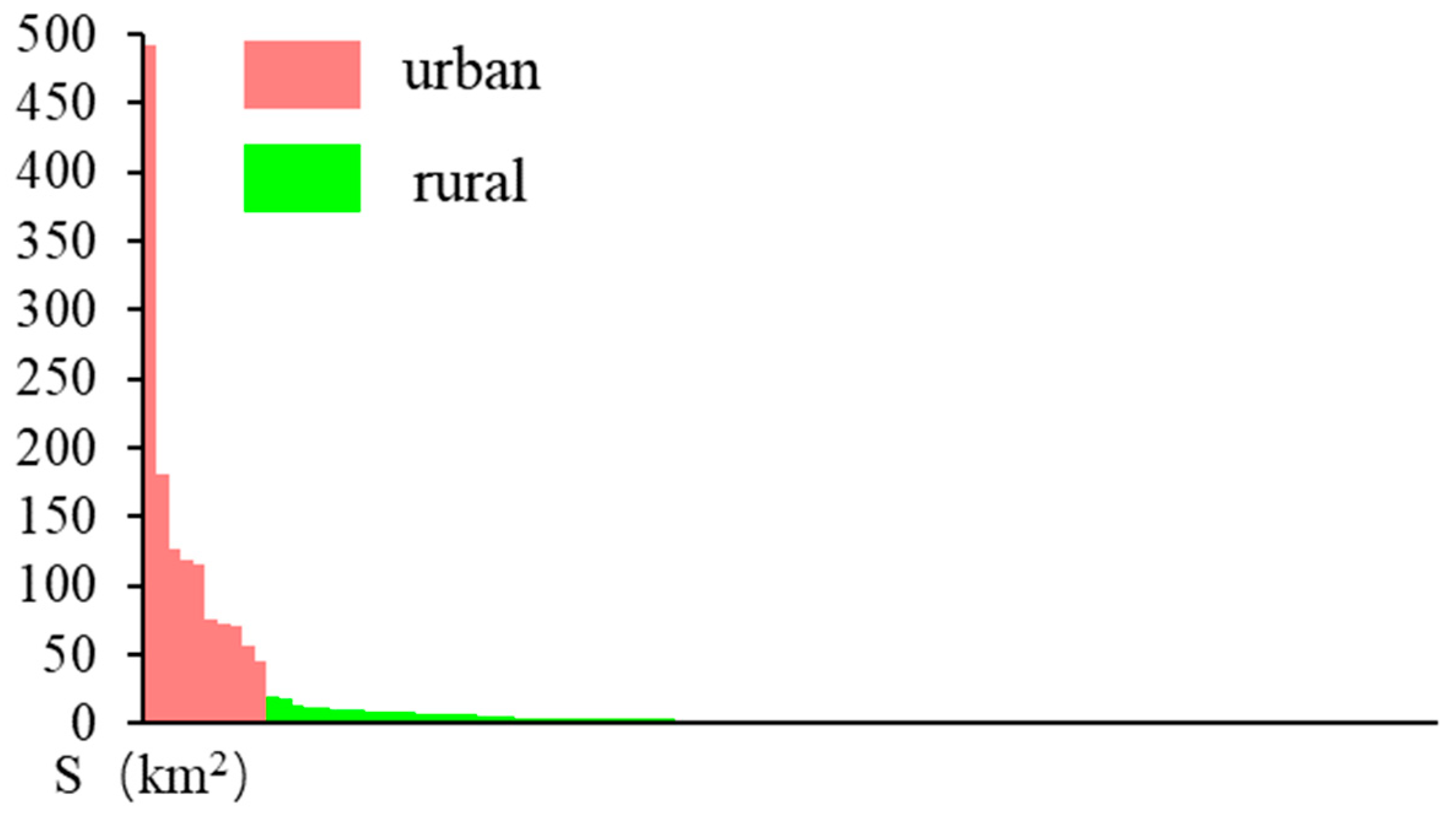
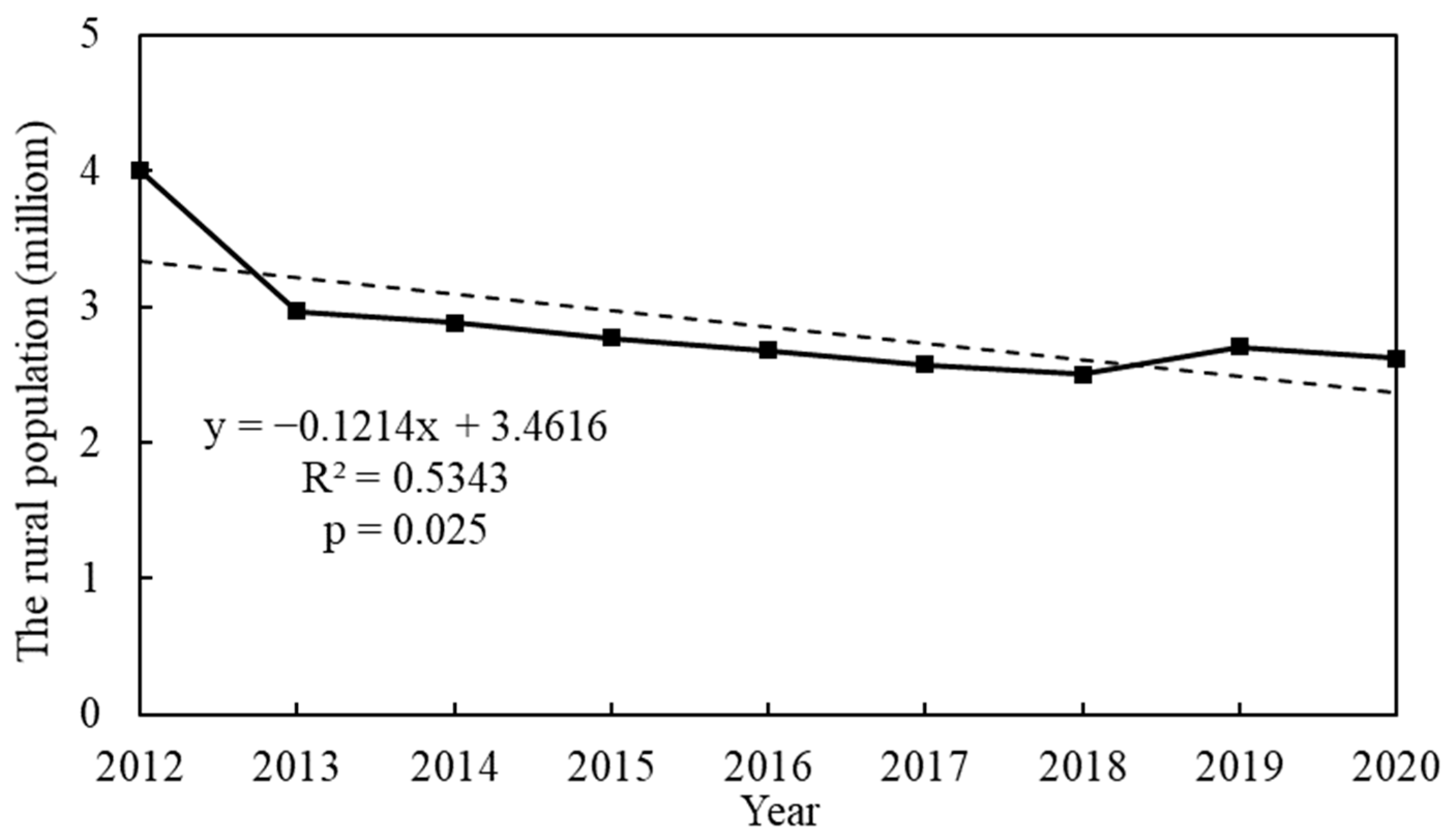

References
- Mayer, H.; Habersetzer, A.; Meili, R. Rural-urban linkages and sustainable regional development: The role of entrepreneurs in linking peripheries and centers. Sustainability 2016, 8, 745. [Google Scholar] [CrossRef]
- Liu, Y.; Liu, Y.; Chen, Y.; Long, H. The process and driving forces of rural hollowing in China under rapid urbanization. J. Geogr. Sci. 2010, 20, 876–888. [Google Scholar] [CrossRef]
- Davoudi, S. European briefing: Polycentricity in european spatial planning: From an analytical tool to a normative agenda. Eur. Plan. Stud. 2003, 11, 979–999. [Google Scholar] [CrossRef]
- Meijers, E. Measuring polycentricity and its promises. Eur. Plan. Stud. 2008, 16, 1313–1323. [Google Scholar] [CrossRef]
- Cox, D.T.C.; Sánchez de Miguel, A.; Bennie, J.; Dzurjak, S.A.; Gaston, K.J. Majority of artificially lit Earth surface associated with the non-urban population. Sci. Total Environ. 2022, 841, 156782. [Google Scholar] [CrossRef]
- Almeida, M.; Loupa-Ramos, I.; Menezes, H.; Carvalho-Ribeiro, S.; Guiomar, N.; Pinto-Correia, T. Urban population looking for rural landscapes: Different appreciation patterns identified in Southern Europe. Land Use Policy 2016, 53, 44–55. [Google Scholar] [CrossRef]
- Chen, K.; Long, H.; Liao, L.; Tu, S.; Li, T. Land use transitions and urban-rural integrated development: Theoretical framework and China’s evidence. Land Use Policy 2020, 92, 104465. [Google Scholar] [CrossRef]
- Penazzi, S.; Accorsi, R.; Manzini, R. Planning low carbon urban-rural ecosystems: An integrated transport land-use model. J. Clean. Prod. 2019, 235, 96–111. [Google Scholar] [CrossRef]
- Peng, J.; Liu, Q.; Blaschke, T.; Zhang, Z.; Liu, Y.; Hu, Y.n.; Wang, M.; Xu, Z.; Wu, J. Integrating land development size, pattern, and density to identify urban–rural fringe in a metropolitan region. Landsc. Ecol. 2020, 35, 2045–2059. [Google Scholar] [CrossRef]
- Cui, J.; Luo, J.; Kong, X.; Sun, J.; Gu, J. Characterising the hierarchical structure of urban-rural system at county level using a method based on interconnection analysis. J. Rural Stud. 2022, 93, 263–272. [Google Scholar] [CrossRef]
- Liu, Y. Introduction to land use and rural sustainability in China. Land Use Policy 2018, 74, 1–4. [Google Scholar] [CrossRef]
- Wang, C.; Liu, Y.; Kong, X.; Li, J. Spatiotemporal decoupling between population and construction land in urban and rural Hubei province. Sustainability 2017, 9, 1258. [Google Scholar] [CrossRef]
- Wang, X.; Hong, J.; Fan, P.; Xu, S.; Chai, Z.; Zhuo, Y. Is China’s urban–rural difference in population aging rational? An international comparison with key indicators. Growth Change 2021, 52, 1866–1891. [Google Scholar] [CrossRef]
- Silva, S.; Soares, I.; Pinho, C. Electricity residential demand elasticities: Urban versus rural areas in Portugal. Energy 2018, 144, 627–632. [Google Scholar] [CrossRef]
- Liu, J.; Nijkamp, P.; Lin, D. Urban-rural imbalance and tourism-led growth in China. Ann. Tourism Res. 2017, 64, 24–36. [Google Scholar] [CrossRef]
- Liu, Y.; Long, C. Urban and rural income gap: Does urban spatial form matter in China? SAGE Open. 2021, 11, 21582440211002215. [Google Scholar] [CrossRef]
- Ma, W.; Jiang, G.; Li, W.; Zhou, T. How do population decline, urban sprawl and industrial transformation impact land use change in rural residential areas? A comparative regional analysis at the peri-urban interface. J. Clean. Prod. 2018, 205, 76–85. [Google Scholar] [CrossRef]
- Wei, W.; Zhang, X.; Liu, C.; Zhou, J.; Xie, B.; Li, C. Spatial interaction of urban-rural system and influence pattern in the arid inland river basin—A case study in Shiyang river basin in Northwest China. Pol. J. Environ. Stud. 2021, 30, 3307–3316. [Google Scholar] [CrossRef]
- Su, C.-W.; Liu, T.-Y.; Chang, H.-L.; Jiang, X.-Z. Is urbanization narrowing the urban-rural income gap? A cross-regional study of China. Habitat Int. 2015, 48, 79–86. [Google Scholar] [CrossRef]
- Sun, M.; Fan, H. Detecting and analyzing urban centers based on the localized contour tree method using taxi trajectory data: A case study of Shanghai. ISPRS Int. J. Geo-Inf. 2021, 10, 220. [Google Scholar] [CrossRef]
- Deng, Y.; Liu, J.; Liu, Y.; Luo, A. Detecting urban polycentric structure from POI data. ISPRS Int. J. Geo-Inf. 2019, 8, 283. [Google Scholar] [CrossRef]
- Ladle, A.; Galpern, P.; Doyle-Baker, P. Measuring the use of green space with urban resource selection functions: An application using smartphone GPS locations. Landsc. Urban Plann. 2018, 179, 107–115. [Google Scholar] [CrossRef]
- Zhai, Y.; Wu, H.; Fan, H.; Wang, D. Using mobile signaling data to exam urban park service radius in Shanghai: Methods and limitations. Comput. Environ. Urban Syst. 2018, 71, 27–40. [Google Scholar] [CrossRef]
- Zou, H.; Yue, Y.; Li, Q.-Q. Urban traffic state explained by road networks and spatial variance: Approach using floating car data. Transportat. Res. Rec. 2014, 2467, 40–48. [Google Scholar] [CrossRef]
- Huang, J.; Rozelle, S.; Zhu, X.; Zhao, S.; Sheng, Y. Agricultural and rural development in China during the past four decades: An introduction. Aust. J. Agric. Resour. Econ. 2020, 64, 1–13. [Google Scholar] [CrossRef]
- Kaufman, C.N. Where are the values voters? Ideological constraint and stability among rural, suburban, and urban populations in the United States. J. Rural Stud. 2021, 88, 169–180. [Google Scholar] [CrossRef]
- Liu, X.; Liu, Z.; Zhong, H.; Jian, Y.; Shi, L. Multi-dimension evaluation of rural development degree and its uncertainties: A comparison analysis based on three different weighting assignment methods. Ecol. Indic. 2021, 130, 108096. [Google Scholar] [CrossRef]
- Hara, Y.; Takeuchi, K.; Okubo, S. Urbanization linked with past agricultural landuse patterns in the urban fringe of a deltaic Asian mega-city: A case study in Bangkok. Landsc. Urban Plann. 2005, 73, 16–28. [Google Scholar] [CrossRef]
- Gu, F.X.; Liu, W.B. Change detection of coastal landscape pattern using gis: A case study of Tianjin Binhai new area. Adv. Mater. Res. 2012, 418, 2032–2035. [Google Scholar] [CrossRef]
- He, C.; Ma, Q.; Li, T.; Yang, Y.; Liu, Z. Spatiotemporal dynamics of electric power consumption in Chinese Mainland from 1995 to 2008 modeled using DMSP/OLS stable nighttime lights data. J. Geogr. Sci. 2012, 22, 125–136. [Google Scholar] [CrossRef]
- Li, X.; Li, D. Can night-time light images play a role in evaluating the Syrian Crisis? Int. J. Remote Sens. 2014, 35, 6648–6661. [Google Scholar] [CrossRef]
- Ma, T.; Zhou, Y.; Zhou, C.; Haynie, S.; Pei, T.; Xu, T. Night-time light derived estimation of spatio-temporal characteristics of urbanization dynamics using DMSP/OLS satellite data. Remote Sens. Environ. 2015, 158, 453–464. [Google Scholar] [CrossRef]
- Zhuo, L.; Ichinose, T.; Zheng, J.; Chen, J.; Shi, P.J.; Li, X. Modelling the population density of China at the pixel level based on DMSP/OLS non-radiance-calibrated night-time light images. Int. J. Remote Sens. 2009, 30, 1003–1018. [Google Scholar] [CrossRef]
- Levin, N.; Kyba, C.C.M.; Zhang, Q.; Sánchez de Miguel, A.; Román, M.O.; Li, X.; Portnov, B.A.; Molthan, A.L.; Jechow, A.; Miller, S.D.; et al. Remote sensing of night lights: A review and an outlook for the future. Remote Sens. Environ. 2020, 237, 111443. [Google Scholar] [CrossRef]
- Chen, Z.; Yu, S.; You, X.; Yang, C.; Wang, C.; Lin, J.; Wu, W.; Yu, B. New nighttime light landscape metrics for analyzing urban-rural differentiation in economic development at township: A case study of Fujian province, China. Appl. Geog. 2023, 150, 102841. [Google Scholar] [CrossRef]
- Wu, Q.; Liu, H.; Wang, S.; Yu, B.; Beck, R.; Hinkel, K. A localized contour tree method for deriving geometric and topological properties of complex surface depressions based on high-resolution topographical data. Int. J. Geogr. Inf. Sci. 2015, 29, 2041–2060. [Google Scholar] [CrossRef]
- Elvidge, C.D.; Baugh, K.E.; Kihn, E.A.; Kroehl, H.W.; Davis, E.R. Mapping city lights with nighttime data from the dmsp operational linescan system. Photogramm. Eng. Remote Sens. 1997, 63, 727–734. [Google Scholar]
- Zhang, B.; Li, J.; Wang, M.; Duan, P.; Li, C. Using DMSP/OLS and NPP/VIIRS images to analyze the expansion of 21 urban agglomerations in mainland China. J. Urban. Plan. Dev. 2021, 147, 04021024. [Google Scholar] [CrossRef]
- Justice, C.O.; Román, M.O.; Csiszar, I.; Vermote, E.F.; Wolfe, R.E.; Hook, S.J.; Friedl, M.; Wang, Z.; Schaaf, C.B.; Miura, T.; et al. Land and cryosphere products from Suomi NPP VIIRS: Overview and status. J. Geophys. Res. 2013, 118, 9753–9765. [Google Scholar] [CrossRef]
- Shi, K.; Huang, C.; Yu, B.; Yin, B.; Huang, Y.; Wu, J. Evaluation of NPP-VIIRS night-time light composite data for extracting built-up urban areas. Remote. Sens. Lett. 2014, 5, 358–366. [Google Scholar] [CrossRef]
- Elvidge, C.D.; Baugh, K.; Zhizhin, M.; Hsu, F.C.; Ghosh, T. VIIRS night-time lights. Int. J. Remote Sens. 2017, 38, 5860–5879. [Google Scholar] [CrossRef]
- Chen, Z.; Yu, B.; Song, W.; Liu, H.; Wu, Q.; Shi, K.; Wu, J. A New Approach for Detecting Urban Centers and Their Spatial Structure With Nighttime Light Remote Sensing. IEEE Tran. Geosci. Remote 2017, 55, 6305–6319. [Google Scholar] [CrossRef]
- Li, D.; Zhao, X.; Li, X. Remote sensing of human beings-a perspective from nighttime light. Geo-spat. Inf. Sci. 2016, 19, 69–79. [Google Scholar] [CrossRef]
- Chen, J.; Liu, J.; Qi, J.; Gao, M.; Cheng, S.; Li, K.; Xu, C. City- and county-level spatio-temporal energy consumption and efficiency datasets for China from 1997 to 2017. Sci. Data. 2022, 9, 101. [Google Scholar] [CrossRef]
- Zheng, J.; Feng, G.; Ren, Z.; Qi, N.; Coffman, D.M.; Zhou, Y.; Wang, S. China’s energy consumption and economic activity at the regional level. Energy 2022, 259, 124948. [Google Scholar] [CrossRef]
- Qu, Y.; Jiang, G.-h.; Li, Z.; Tian, Y.; Wei, S. Understanding rural land use transition and regional consolidation implications in China. Land Use Policy 2019, 82, 742–753. [Google Scholar] [CrossRef]
- Lu, H.; Zhao, P.; Hu, H.; Zeng, L.; Wu, K.S.; Lv, D. Transport infrastructure and urban-rural income disparity: A municipal-level analysis in China. J. Transp. Geog. 2022, 99, 103292. [Google Scholar] [CrossRef]
- Gao, J.; Song, G.; Sun, X. Does labor migration affect rural land transfer? Evidence from China. Land Use Policy 2020, 99, 105096. [Google Scholar] [CrossRef]
- Ning, J.; Liu, J.; Kuang, W.; Xu, X.; Zhang, S.; Yan, C.; Li, R.; Wu, S.; Hu, Y.; Du, G.; et al. Spatiotemporal patterns and characteristics of land-use change in China during 2010–2015. J. Geogr. Sci. 2018, 28, 547–562. [Google Scholar] [CrossRef]
- Zhang, H.; Zhang, S.; Liu, Z. Evolution and influencing factors of China’s rural population distribution patterns since 1990. PLoS ONE 2020, 15, e0233637. [Google Scholar] [CrossRef]
- Gibson, J.; Olivia, S.; Boe-Gibson, G.; Li, C. Which night lights data should we use in economics, and where? J. Dev. Econ. 2021, 149, 102602. [Google Scholar] [CrossRef]
- Guo, H.; Dou, C.; Chen, H.; Liu, J.; Fu, B.; Li, X.; Zou, Z.; Liang, D. SDGSAT-1: The world’s first scientific satellite for sustainable development goals. Sci. Bull. 2023, 68, 34–38. [Google Scholar] [CrossRef]

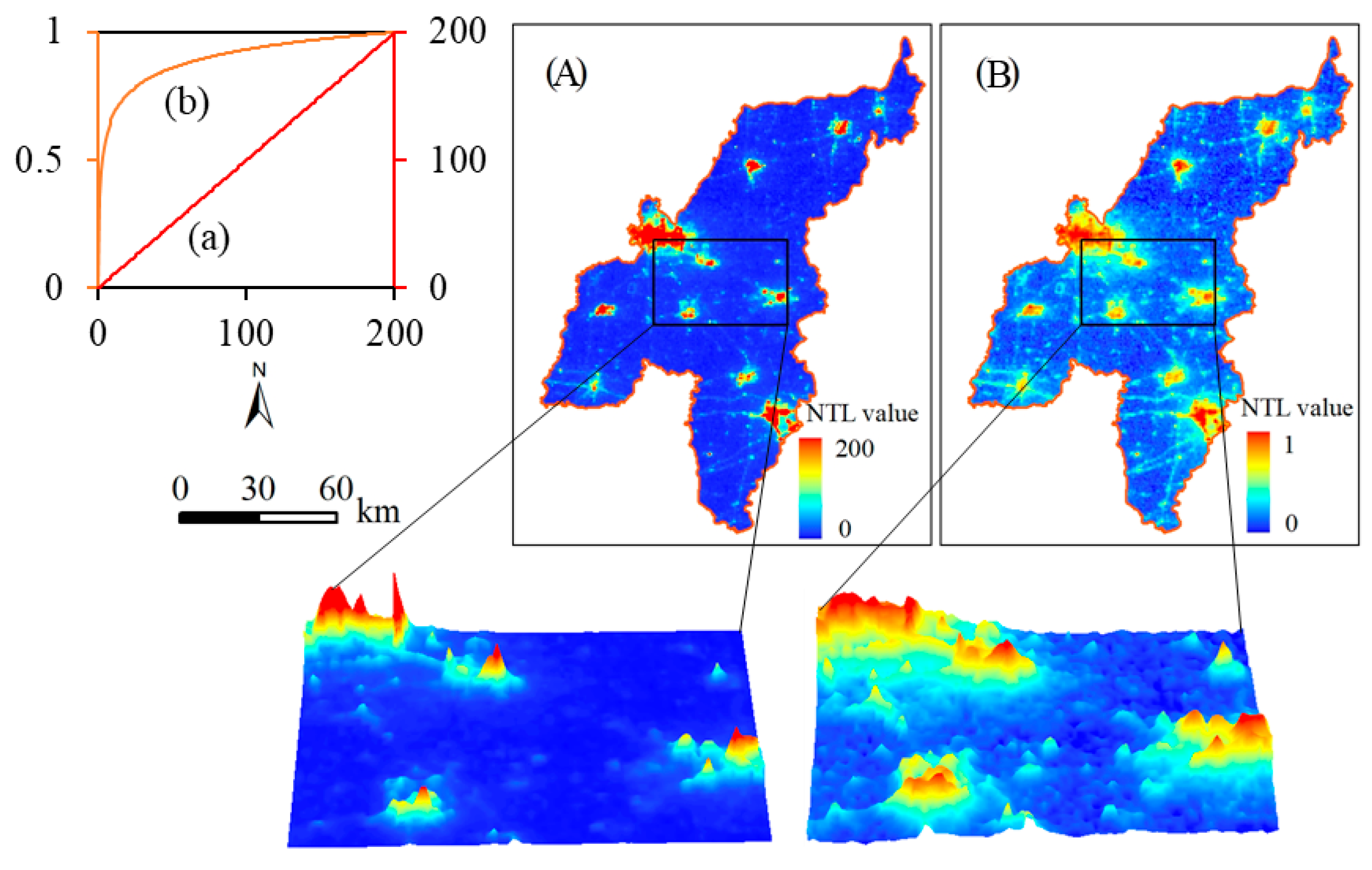
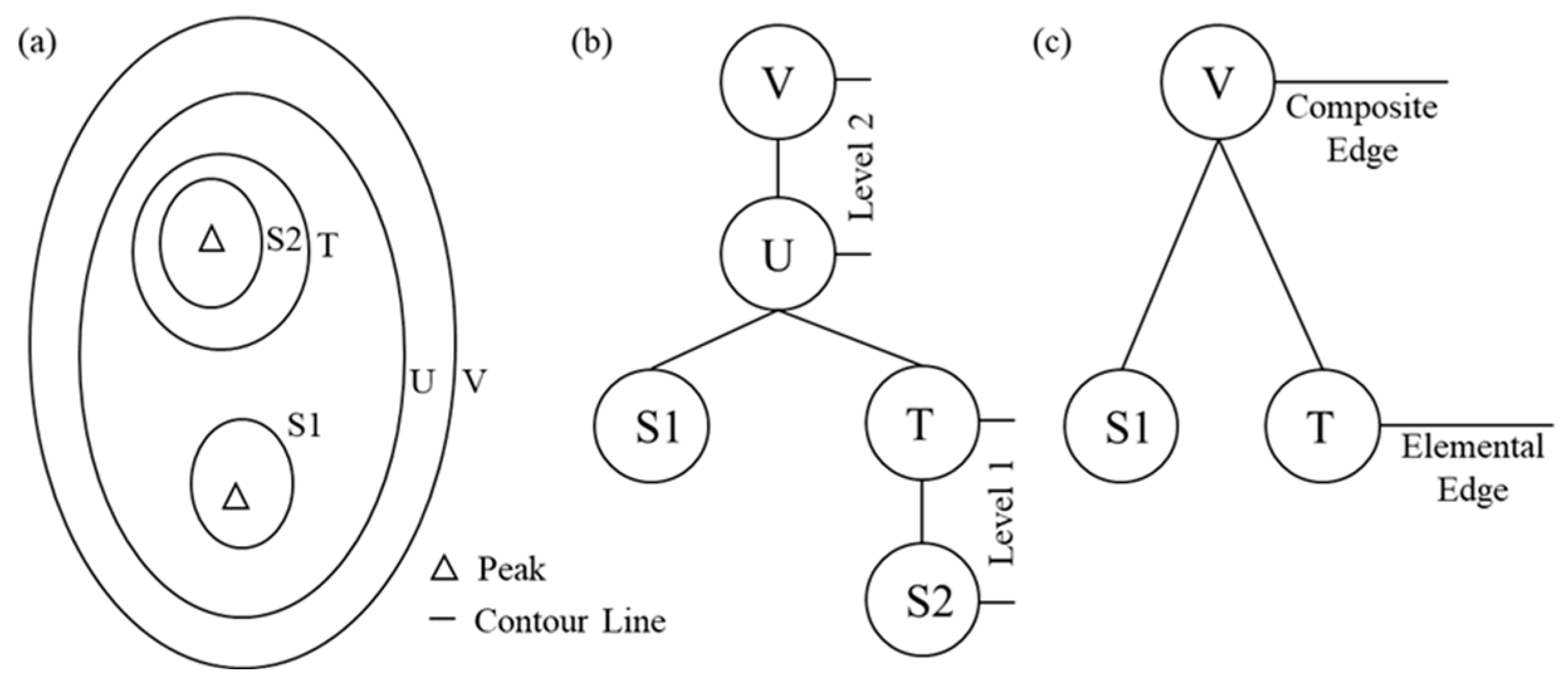
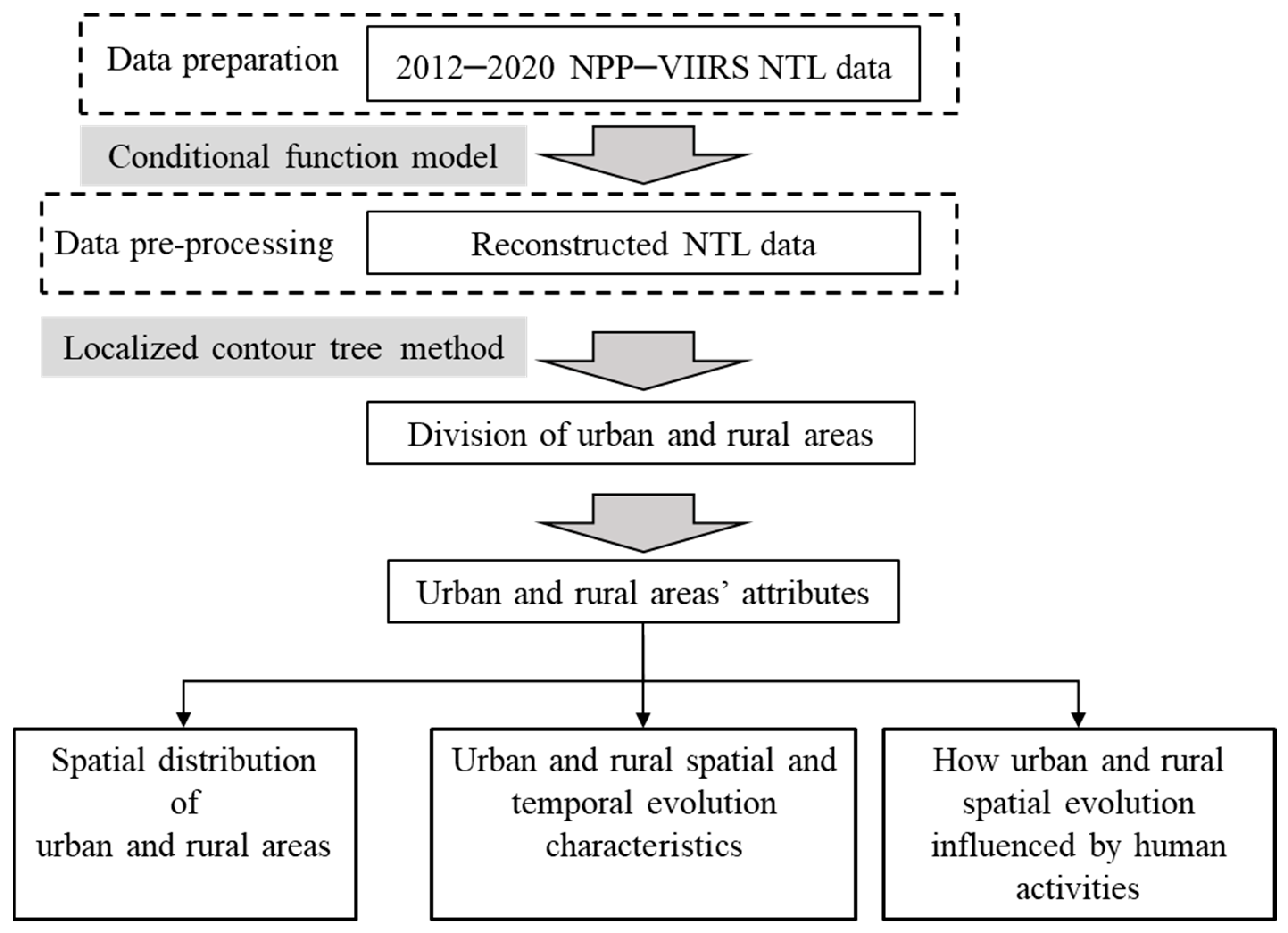
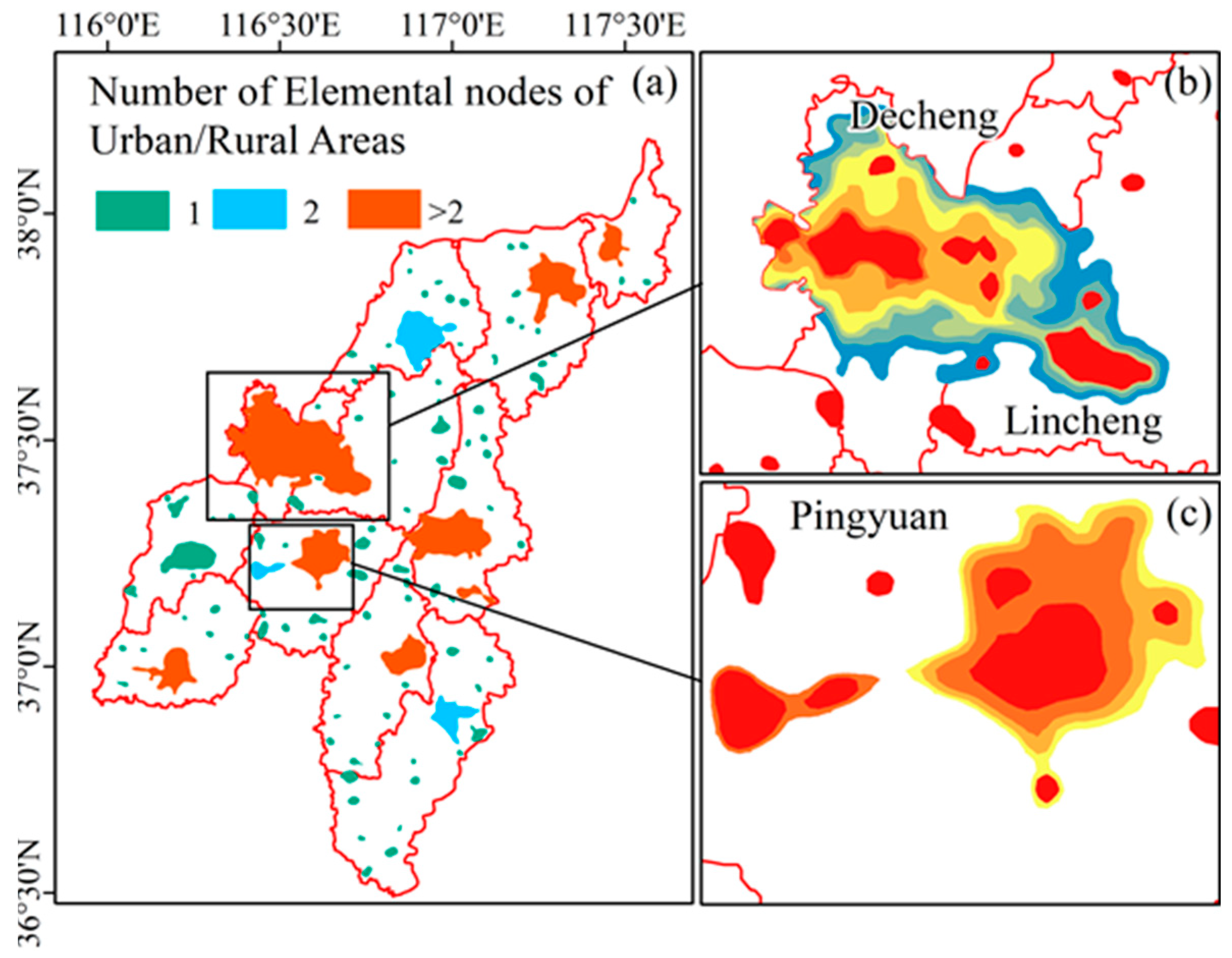
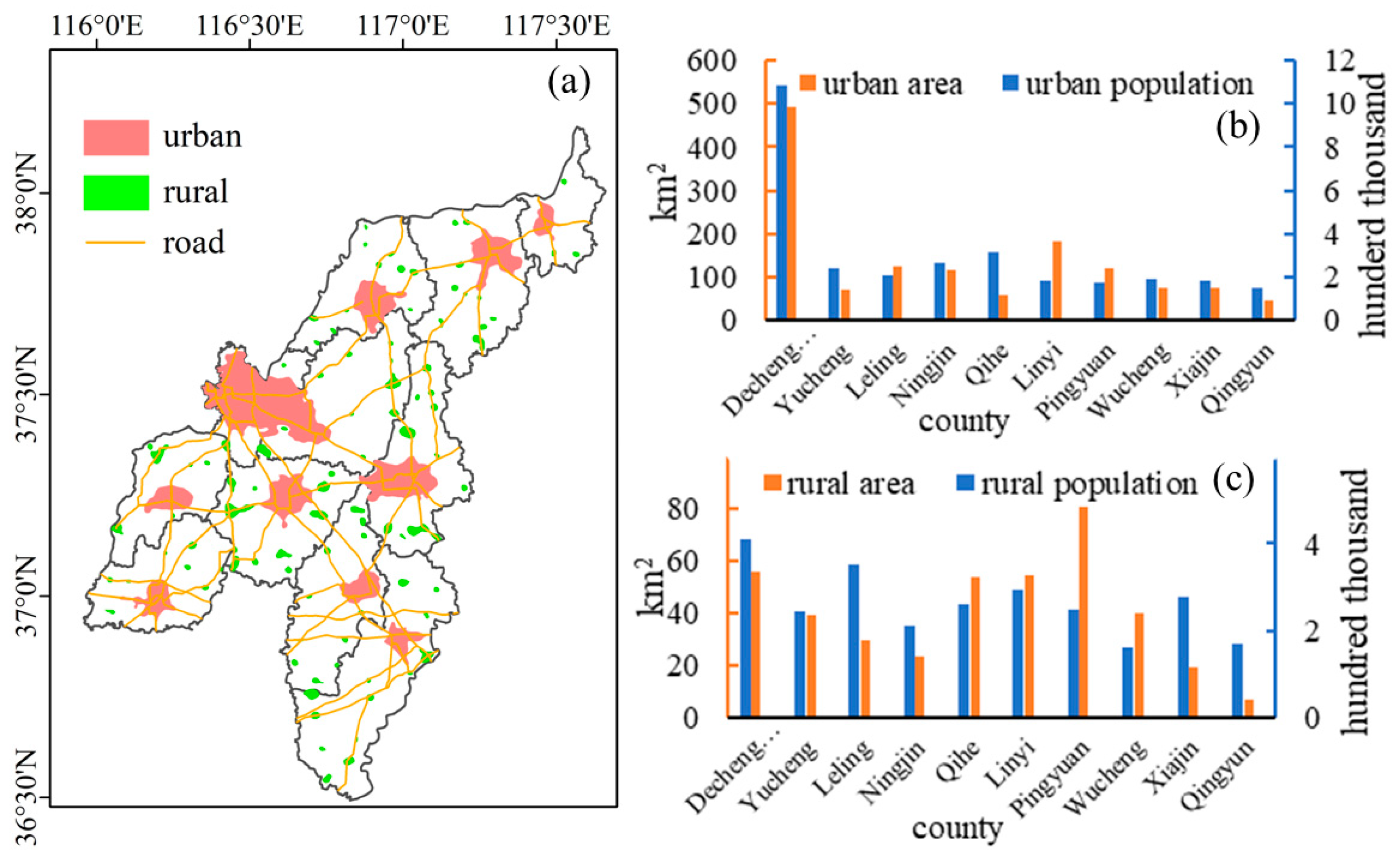
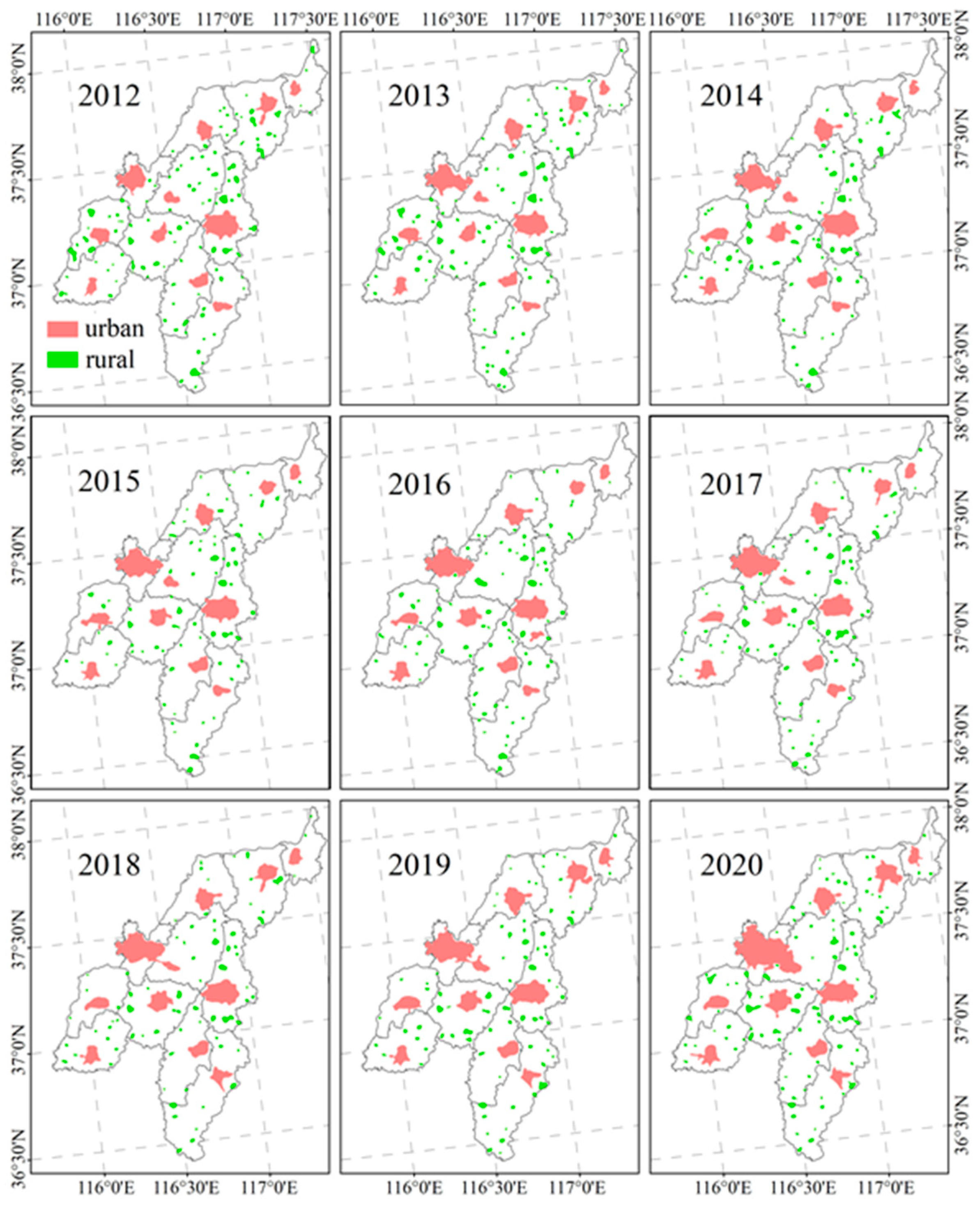
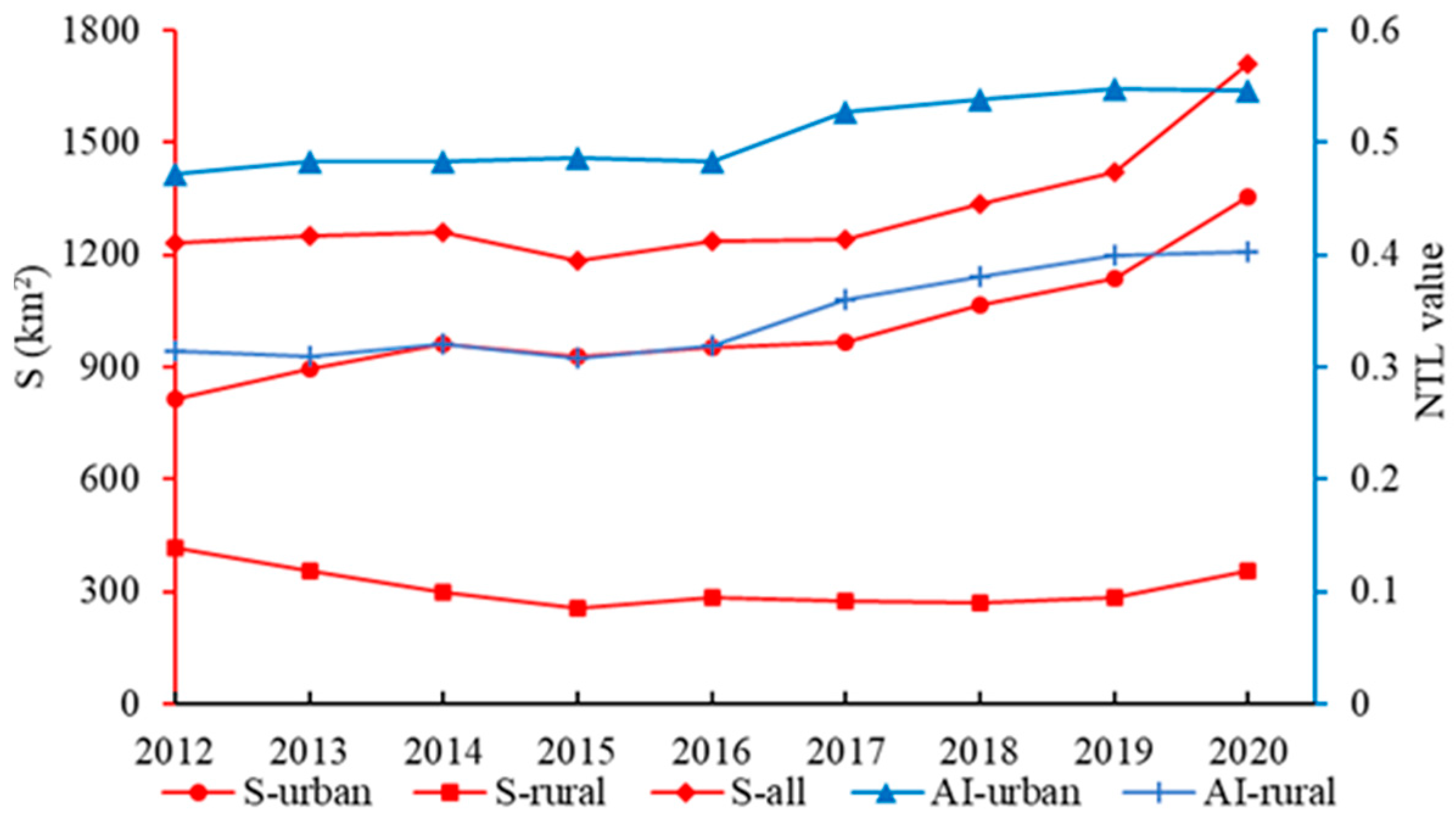
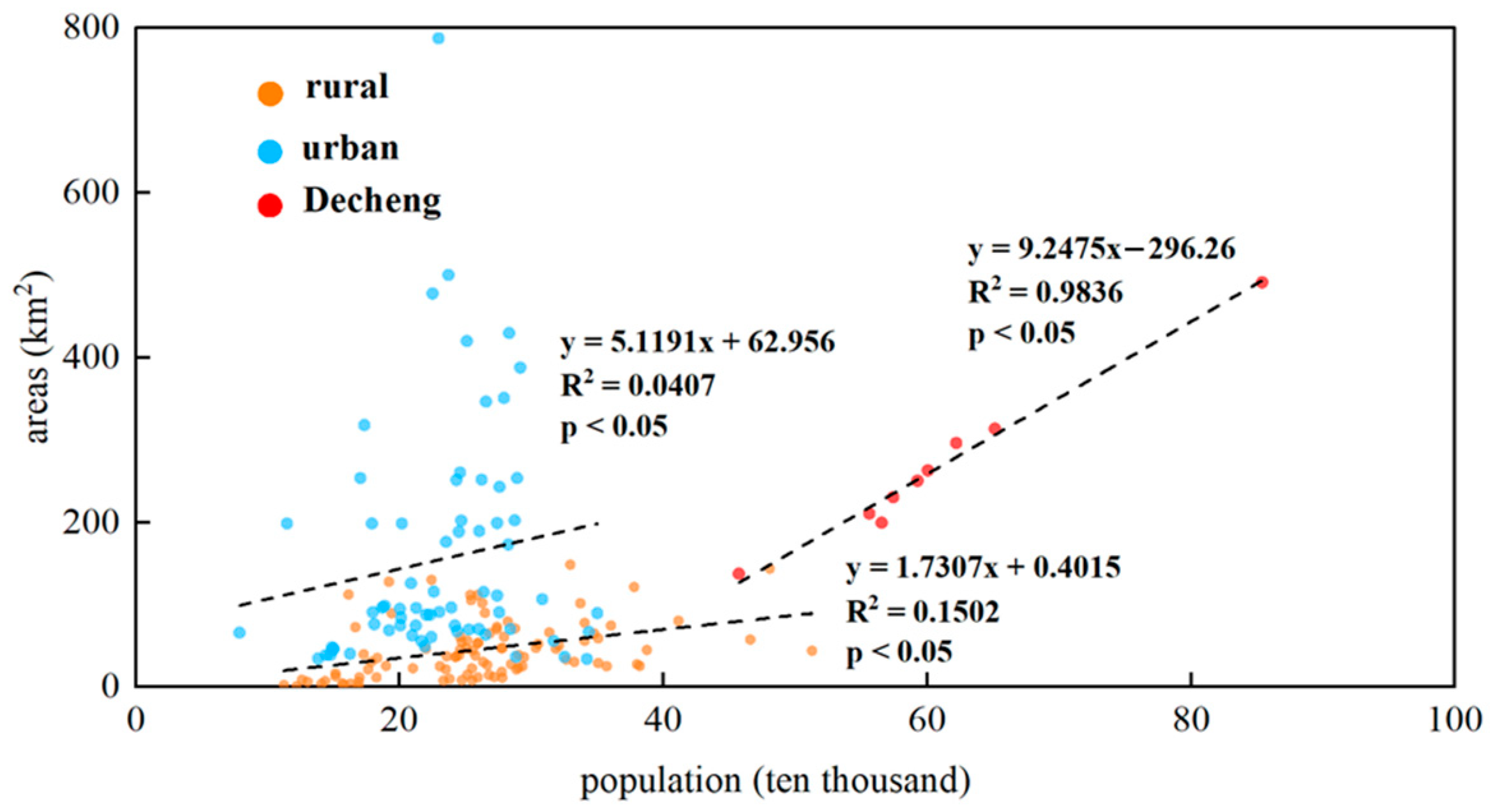
| Attribute | Definition |
|---|---|
| Minimum Intensity (MIN) | : is the number of pixels in an urban/rural region and is the nighttime light intensity value of the ith pixel. |
| Maximum Intensity (MAX) | |
| Total Nighttime Light Intensity (TNTL) | |
| Area (S) | : is the grid cell size. is the area of an urban/rural region. |
| Average Intensity (AI) | |
| Standard Deviation of Intensity (STD) | : indicates the average nighttime light value in a contour object. |
| Compactness index (CI) | : P is the perimeter of an urban/rural region. |
Disclaimer/Publisher’s Note: The statements, opinions and data contained in all publications are solely those of the individual author(s) and contributor(s) and not of MDPI and/or the editor(s). MDPI and/or the editor(s) disclaim responsibility for any injury to people or property resulting from any ideas, methods, instructions or products referred to in the content. |
© 2023 by the authors. Licensee MDPI, Basel, Switzerland. This article is an open access article distributed under the terms and conditions of the Creative Commons Attribution (CC BY) license (https://creativecommons.org/licenses/by/4.0/).
Share and Cite
Zhong, H.; Liu, Z.; Huang, Y. Exploring Divergent Patterns and Dynamics of Urban and Active Rural Developments—A Case Study of Dezhou City. ISPRS Int. J. Geo-Inf. 2023, 12, 362. https://doi.org/10.3390/ijgi12090362
Zhong H, Liu Z, Huang Y. Exploring Divergent Patterns and Dynamics of Urban and Active Rural Developments—A Case Study of Dezhou City. ISPRS International Journal of Geo-Information. 2023; 12(9):362. https://doi.org/10.3390/ijgi12090362
Chicago/Turabian StyleZhong, Huimin, Zhengjia Liu, and Yihang Huang. 2023. "Exploring Divergent Patterns and Dynamics of Urban and Active Rural Developments—A Case Study of Dezhou City" ISPRS International Journal of Geo-Information 12, no. 9: 362. https://doi.org/10.3390/ijgi12090362
APA StyleZhong, H., Liu, Z., & Huang, Y. (2023). Exploring Divergent Patterns and Dynamics of Urban and Active Rural Developments—A Case Study of Dezhou City. ISPRS International Journal of Geo-Information, 12(9), 362. https://doi.org/10.3390/ijgi12090362






